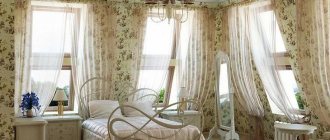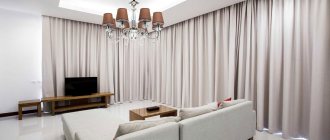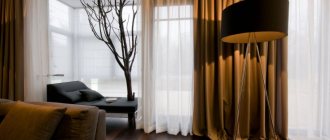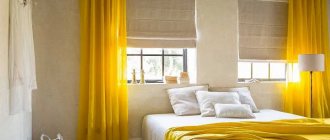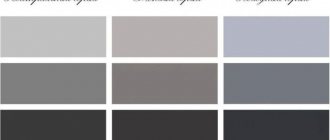If you are looking for how to decorate your windows in a way that is both practical and beautiful, pay attention to Japanese-style curtains. Let's talk about them in more detail.
Using Japanese-style curtains on windows Source dekormyhome.ru
Japanese-style panel curtains on floor-to-ceiling windows Source homeli.ru
How to decorate windows in a house with Japanese curtains Source berkem.ru
Light Japanese curtains decorate window openings in the house Source design-homes.ru
Japanese curtains (also called panel curtains) are flat, wide pieces of fabric or other material. At the top they move along a special narrow cornice, and at the bottom they are equipped with weights. That is, such curtains are similar in design to vertical blinds, but consist of fewer stripes, and each of them is much wider.
Interior with Japanese fabric curtains on the windows Source tekstilprofi.com
Basically, Japanese curtains are used for large floor-to-floor or almost floor-to-floor windows for their intended purpose - to protect from sunlight. In addition, they are convenient for blocking doorways and zoning space in any room of an apartment or house.
Window decor in the office using Japanese curtains Source design-homes.ru
Such curtains come from Japan, a country where minimalism dominates in architecture and interior design. Therefore, they are most suitable for simple, concise and modest design options. Of course, it is also possible to fit them into a room with a luxurious and sophisticated appearance, but it will be more difficult.
Japanese curtains made of bright fabric - the highlight of the interior Source olyta.ru
The design of all such curtains is the same, but the materials from which they are made may be different. In a classic Japanese interior, preference is given to natural materials, and not only fabrics, but also, for example, straw or bamboo. But this is only one of the options.
Curtains in the dining room Source profdekor.ru
Red option for the kitchen Source tkac.ru
Linen
Perhaps this is the most versatile type of Japanese-style curtains. They will fit into almost any interior. Linen goes well with both natural materials, such as stone and wood, and with artificial finishes, metal, plastic and the like.
Japanese style curtains made of natural linen fabric Source tapecariabrejao.com.br
See also: Catalog of companies that specialize in interior planning.
Made from rice paper
Such curtains will fit perfectly into Japanese or other minimalist oriental interiors. They are suitable for any room except the bedroom. This is because they protect from direct sunlight, but let in a lot of light.
Decorating the windows of the house with vertical curtains in the Japanese style with rice paper canvases Source brosko24.rf
Made from blackout fabric
Blackout is a special material that completely absorbs light and does not let it into the room. Curtains with it are best hung in the bedroom and in other rooms where you may need to achieve complete darkness even in the midst of a sunny day.
Panel curtains made of opaque blackout fabric in the bedroom interior Source berkem.ru
Satin
Such curtains are a practical and economical solution. Satin boasts an affordable price, long service life and a wide variety of colors. Along with linen, satin Japanese curtains are the easiest to fit into any interior design.
Silk
Natural silk is an expensive and luxurious fabric that, if chosen correctly, can literally transform the interior. Silk curtains are incredibly beautiful both in a single color solution and when decorated with ornaments or designs based on traditional oriental motifs.
But due to their beauty and sophistication, such curtains are not suitable for all rooms. For example, in a tiny loft-style bedroom they will definitely look alien. It is better to hang them in large spacious rooms with luxurious and “rich” interiors.
Bamboo
Bamboo curtains are easy to care for, durable and provide a high, although not complete, level of shading of the room. They harmonize well with interiors in Arabic and Asian oriental styles, eco-style, minimalism, contemporary and even loft. In a word, in all those designs that combine brevity and active use of natural materials.
Oriental home interior with Japanese curtains made of bamboo fibers Source dizainexpert.ru
From organza
Organza is a transparent fabric made from synthetic and natural fibers. Due to its transparency, it visually lightens the interior, making it more airy and weightless. But because of it, it does not protect from the sun in any way. Therefore, it is worth using such curtains either in combination with opaque ones, or in those rooms that do not need shading.
Plastic
Often the role of these curtains is not only and not so much functional as aesthetic. They are not just one of the many interior details, but an important stylistic accent. For this purpose, curtains are made in bright colors and provided with perforations.
An important nuance is that they use special plastic that is especially resistant to prolonged exposure to ultraviolet radiation. That is, you can be sure that your curtains will not fade or lose strength after just a month of use.
Convenient rope mechanism for controlling fabrics in Japanese curtains Source karniz-ekb.ru
Japanese curtains with a convenient electric drive for moving the curtains Source m-karniz.com
Types of control of curtain panels:
- Manual. It is convenient if there are several canvases and you rarely need to move them.
- On a cord or rod. Allows you to conveniently control the canvases without touching them.
- Automatic.
Positive and negative qualities
We are all accustomed to standard curtain models, that is, a large canvas assembled into hundreds of folds of different sizes. Japanese curtains, including IKEA, are not familiar to us. But this type has a number of advantages:
- a wide range of. You will have the opportunity to choose your own color, pattern and material;
- thanks to the straight fabric, such a curtain does not accumulate dust, unlike curtains with a large number of folds;
- for panoramic windows this is just a godsend. Especially if the fabric starts from the ceiling and ends at the very bottom.
In addition to the positive qualities include the unusual design and originality of Japanese models. Everything can't be perfect. There are minor drawbacks: restrictions on shape, curtains are made only in rectangular and square shapes. And of course, an unusual look that you will have to get used to.
How are they secured?
The fastening of Japanese curtains resembles roller blinds. Indeed, there are slight similarities, but they differ in that the Japanese model can be fixed in several rows. This is possible thanks to a special cornice attached to the ceiling.
To keep the curtains in place, there is no need to buy hooks, there are original fasteners:
- special hangers. The curtain opens and closes using rollers. These hangers have a drawback: the fabric will bunch up even if you attach a weight to the hem;
- sticky base - sticky tape is glued to the plastic on the cornice.
You can adjust the curtain:
- manually, pulling the cane, lace or moving the canvas by hand;
- using a remote control, an electric mechanism is built into the design, which, when you press a button, moves the curtain.
Japanese curtains in the interior
Despite the simplicity of appearance and mechanism, Japanese models can become an original decoration for home design. If you look at the photo of Japanese-style curtains, you will see how their simplicity and unusualness gives style to any room. Everything you need to choose correctly for the overall interior.
For kitchen
According to customs in Japan, a quiet and calm environment should prevail in the kitchen while cooking. In this case, the cook gives himself completely to the process and serves a delicious dish prepared with love.
It is recommended to choose light, unobtrusive patterns for the kitchen. Or monochromatic colors of nature: green (like trees, grass), brown (like a rock, stone).
Stick with the option without print. Curtains made of bamboo or straw are also suitable. If you prefer fabric, then choose artificial one. It is easier to wash and does not absorb odors.
As for the sizes, be guided by the size of the kitchen. If the room is small, then opt for small curtains, up to the length of the window sill. For large kitchens, you can purchase floor-length models.
Bedroom
Since this room is intended for long periods of rest and sleep, the curtains here should be free from excessive pretentiousness: they should be as elegant, peaceful and soothing as possible. Light twilight is allowed in the bedroom, which will promote healthy sleep. Before choosing curtains here, it is important to take into account all the nuances of the interior:
- Color of walls and furnishings;
- Textures in the interior;
- Lighting.
For this room, the most successful shades will be light pastel shades such as caramel, café au lait, champagne, lavender, peach, sky, olive and milk chocolate. Bold contrasting solutions will look great.
Advice. Curtains, like the entire interior, should be unobtrusive, pleasant and inspiring a comfortable rest after a hard day. You should not choose Japanese curtains of a rich and deep shade.
With the right choice, you can make the room truly unique, pleasant and comfortable. The main thing is to rely on the advice of experienced designers.
For the living room
Combined variations are suitable for the hall. Japanese curtains can be combined with tulle; together they will fill the room with warmth and comfort. It is very important that in the living room every detail is in harmony with the other.
It is better to choose materials that will not deform in the future - natural, linen, cotton, silk and others. The hall welcomes curtains with bright prints and patterns. Will always be in trend: large flowers, stripes, birds, animals, nature. Don't forget about moderation.
motionless
In this case, thin material is used, which is fixed in frames. This creates a unique, lightweight partition. They are very often used in the east instead of walls and doors. They can be mounted on relays, making them movable.
In residential buildings, they are used as a zoning tool and an opportunity to beautifully decorate a dressing room.
Curtain as a partition
This is a great option to divide your apartment into zones. Do you want to hide an unsightly hanger? Or divide the kitchen and living room area?
Please, a Japanese-style curtain can easily cope with this problem. Moreover, on each side you can choose the appropriate pattern or color.
- Fashionable curtains for the kitchen: new design options for curtains for the kitchen
- Curtains for the living room in a modern style: real design examples (100+ photos)
- The best modern night curtains for the hall (60+ photos)
Some useful tips
Before purchasing this type of curtains, pay attention to the following points:
- Curtains have a different appearance in different light. Therefore, it is worth checking in advance how the canvas looks not only during the day, but also at night. Maybe you will use different light bulbs to finally decide on the ideal model;
- If you're buying a curtain as a dividing wall, don't look at the thin fabric. It will be enlightened and will not give the desired effect. A denser fabric will easily separate one area from another;
- If you have a classic apartment design. Then you should refrain from buying Japanese curtains. Also. They do not harmonize with vintage and retro styles.
The rules for caring for Japanese curtains depend on the material. For some, only dry cleaning is suitable, which can be achieved using a vacuum cleaner. Some fabrics can be cleaned with water and a mild soap solution. Some can be put in the washing machine.
After washing, you need to hang the curtain so that it is completely straightened and dried in the position in which it will hang.
Color spectrum
Japanese paintings will look even more harmonious in the interior if you choose the right one, not only the texture, but also the color.
Brown
Multifaceted, rich, but at the same time neutral color. He is not dominant. Brown color is a natural shade that is suitable for elegant and solid interiors.
Grey
In order not to end up with a too dull and conservative atmosphere in the room, when choosing this color you need to know a sense of proportion and carefully think through each shade and color combination.
Green
The color of calm, imbues the space with a natural theme. Green Japanese curtains create a positive perception of the outside world and the interior as a whole.
The photo shows a white dining room and green Japanese paintings on the windows.
White
This is a sign of excellent taste and grace, because it goes well with any interior and color of furniture, and also gives the living space a festive look.
Black and white
The pinnacle of classics, the absolute peak of harmony. Combines with a variety of bright or muted interior palettes. The black and white combination gives the design a strict laconicism and an incredibly luxurious look. It can become both a background and an accent.
A stunning, deep, rich and incredibly picturesque color that undoubtedly attracts attention.
Pink
Mobilizes and tones, provides ample opportunities to express your taste. It can induce a dreamy mood and is good for relaxation.
Beige
It will fill the design with a special aesthetics, add completeness and allow you to add more coziness and comfort to a cool or dark interior.
The photo shows a living room in light colors with beige Japanese curtains on the window.
Japanese curtains and interior styles
- eastern - this option was created precisely for him;
- eco - it implies naturalness. A Japanese-style curtain made from cotton or linen would be a great option;
- modern - this look was invented quite recently, so it fits perfectly with the modern style;
- hi-tech - this style is characterized by elegance and style. If you choose an unusual material and pattern, they will fit into the overall picture;
- minimalism - simplicity of appearance and form fit this style.
Material of manufacture
The design of these curtains is the same. However, the material used to sew them may differ. Below are the most popular options.
